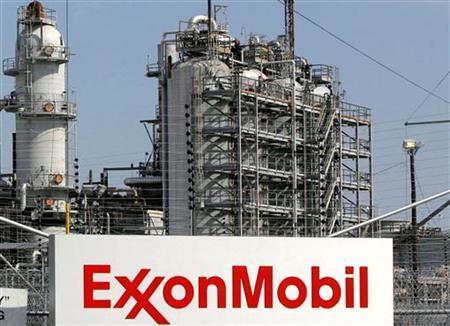
Exxon Mobil Corp. raised $12 billion in its biggest bond sale on record and may use the funds to snap up rivals amid a commodities bust.
The world’s largest oil company, which is at risk of losing its top-notch credit rating, sold the debt in eight parts at above average yields, according to data compiled by Bloomberg. The sale comes after Moody’s Investors Service cut Exxon’s outlook from negative to stable on Feb. 25 and warned that the oil-market collapse imperils cash flow needed to cover debt payments and new investments.
“If you are Exxon, you have to be looking around at all of the wreckage in the energy sector these days and feel like a kid in a candy store,” said Spencer Cutter, an analyst at Bloomberg Intelligence. The debt offer is a sign that Exxon may “start picking up great assets at fire-sale prices” and “take advantage of the downturn and start shopping,” he said.
Exxon said proceeds from the sale may be used toward “funding for working capital, acquisitions, capital expenditures, refinancing a portion of our existing commercial paper borrowings and other business opportunities,” according to a Monday regulatory filing.
‘Generational Opportunity’
With oil prices falling to a 12-year low earlier this month, many energy companies have lost much of their market value.
“We are very surprised there have not been more acquisitions by the big guys — it seems a generational opportunity if you are one of the strongest and biggest,” according to Timothy Doubek, a money manager at Columbia Threadneedle Investments, which has about $176 billion in fixed- income assets under management. “You have to move the needle — you can’t just do little tiny things.”
The longest portion of Exxon’s debt sale is $2.5 billion in 4.114 percent 30-year bonds yielding 150 basis points more than comparable government debt. While that’s lower than an originally offered premium of as much as 180 basis points, according to a person with knowledge of the matter, it’s six basis points more than the average yield on corporate debt of similar maturity and rating, according to Bank of America Merrill Lynch Indexes.
Exxon’s $2.5 billion tranche of 3.043-percent 10-year notes sold at 130 basis points more than comparable Treasuries — a 48 basis-point premium to comparable debt, Bank of America Merrill Lynch data shows.
AAA Ratings
Standard & Poor’s placed Exxon on credit watch with negative implications on Feb. 2, saying that Exxon’s credit measures will probably remain weak through 2018.
Despite the volatility in the energy space, the investment- grade market is increasingly drawn to names like Exxon for their quality and liquidity, said Doubek. The oil giant is one of three U.S. corporate issuers with AAA ratings from Standard & Poor’s, along with Microsoft Corp. and Johnson & Johnson.
That Exxon is at risk of being downgraded isn’t weighing on its borrowing costs as much as the outlook for the rest of the energy industry, according to Andrew Brenner, head of international fixed income at National Alliance Capital Markets in New York, since cuts by Moody’s and S&P are lagging indicators.
“If energy was not in the headlines over the last year, the 30-year would probably come to market at somewhere around 125 basis points,” Brenner said. “Exxon is a great company in what is perceived to be a terrible industry right now.”
Recommended for you
